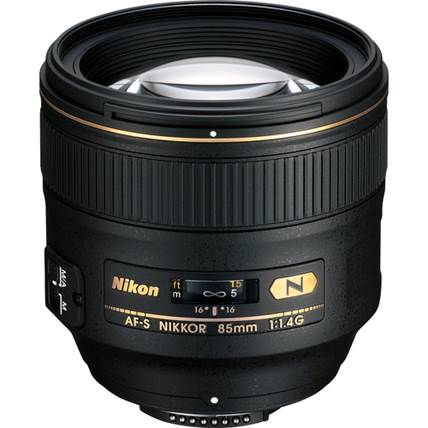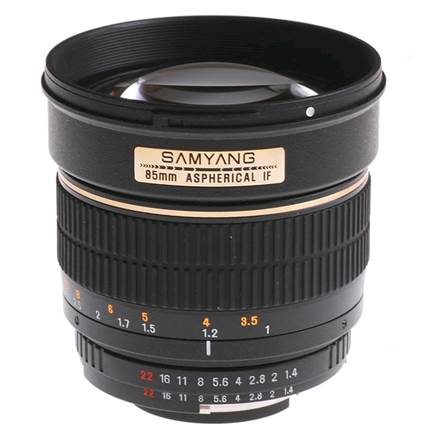Review on the Samyang 85mm f1.4
This review is a work in process and I hope
to add some in-depth comparison and measurements on the quality of bokeh, which
comes with a few comments about the performance of the focus and structure in
the near future. So, right now, I can only comment on the quality of the focus
to infinity.
Independently considering, the Samyang 85mm
f1.4 provides very good results. The quality is quite soft in the middle and
shows some color fringing with wide aperture but then is improved at f4 and when
at f8 it looks very sturdy. Meanwhile, at the corners, the quality looks good,
even with the wide aperture, although oddly, the chromatic aberrations become
more visible when the aperture narrows down. Like our specific samples, it is
hard to pick a sweet spot within the aperture for the entire frame, but the
good news is that the color fringing is easily removed with software tools,
such as tools in Adobe Camera RAW.

Samyang
85mm f1.4 provides very good results.
Everything is fine till now, but how can Samyang
be compared with Nikkor 85mm f1.4G? This is probably an unfair comparison,
because Nikkor lens is at a much higher price, but because both have the same
length and the same scores, it is a comparison that many people will be curious
about.
When both the lenses have the same wide aperture,
they actually particularly are close to each other in quality. Nikkor has a
very small contour in the middle, but Samyang looks a little better in the outer
corners, which is an impressive result in terms of the difference in prices. It
also means that both lenses will be the same in terms of sharpness in their
intended environmental portraits. Again, Nikkor is sharper in the center at f4,
but not so much sharper.
But when both lenses are reduced, the
difference becomes clearer. In the middle, between f1.8 and f2Nikkor improves strongly,
and it is said to provide maximum sharpness between f2.8 and f4. Meanwhile
Samyang is still quite soft when compared at the aperture to f8 and needs to
close before it reaches maximum sharpness – even at f8, Nikkor is still tougher
in the center.
Switching to the corners, Samyang may have
a slight advantage over the Nikkor with the lens aperture between f1.4 and
f2.8, but at f1.4 Nikkor jumps ahead with a result that goes increasingly
sharper when the aperture narrows down, while Samyang, strangely, becomes
softer and subjected to increasing chromatic aberrations.

At
f1.4 Nikkor jumps ahead with a result that goes increasingly sharper when the
aperture narrows down
Therefore, when both lenses have the same
wide aperture, sharpness across the frame is similar, but the aperture gets
narrower, Nikkor quickly takes hold and gives sharp and outstanding results.
Because if you use the lens for shooting landscapes or architectural details,
you will enjoy more with Nikkor, but these f1.4 lenses are aimed primarily at portraits
with wide aperture, at the point where they are very close to each other in
terms of performance. I will add some bokehs and compare the depth soon, but
for now, the results are very promising for the cheaper Samyang f1.4. It is also
important to remember that if you want to reduce lens for better quality,
instead you'll probably come up with a cheaper 85mm f1.8 lens, and I emphasize the
suggestion of Nikkor 85mm f1 .8 G see my review of Nikkor 85mm f1.8G!
Therefore, if you are paying attention to the
performance at f1.4, where is the place to leave Nikkor 85mm f1.4G? In fact, in
terms of performance as focus to infinity, there is not much there, and the
only advantage of the Nikkor is its autofocus capability and its ability to exploit
the whole modern body. It is tough, but models like Samyang 85mm f1.4 are
really vibrant in the market and provide excellent quality with a much lower
price, as long as you are pleased to focus manually.

Samyang
85mm f1.4 is really vibrant in the market and provides excellent quality with a
much lower price.
|
Specifications
·
Manufacturer: Samyang Optics
·
Model: aspherical 85mm f/1.4 IF MC
·
Lens type: excellent telephoto lens
·
Focal length: 85mm
·
Maximum aperture: f1.4
·
Minimum aperture: f/22
·
Viewing angle: 28.5 deg (18.9 deg for
APS-C/DX)
·
Minimum focusing distance: 1m
·
Diaphragm Blades: 8
·
Focus type: MF (manual focus)
·
Lens structures: 9 elements / 7 groups / 1
aspherical lens
·
Dimensions: 78x72.2 mm
·
Weight: 513g
·
Filter’s dimensions: 72mm
·
Available rack: Canon, KM / Sony A Mount,
Pentax, 4/3, Samsung NX
|